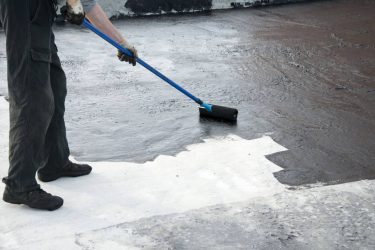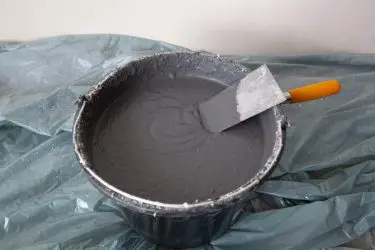There’s nothing worse than putting down a fresh layer of concrete only to find out its surface is all jagged and discolored. Luckily, there’s no need to panic, as this is a pretty common issue that can be fixed by following a few simple steps.
The reasons your concrete will look so rocky are usually due to inconsistencies either in materials or application. Additionally, using an improper water content will prevent your concrete layer from being as smooth as possible.
In the following sections, I’ll delve further into the reasons why your concrete job might be coming out uneven and the steps you can take to fix or (even better) prevent this issue.

Table of Contents
Common Causes of Rocky Looking Concrete
There’s a wide range of elements that can affect the look and texture of concrete, which is why it’s necessary to be extremely careful and steady-handed when completing any job involving this material.
Although, it’s often tricky to pinpoint a single issue causing your concrete layer to come out rocky, as this problem is usually a result of various causes affecting it simultaneously.
Nonetheless, it’s possible to avoid this situation in the future by gaining a better understanding of the most common reasons why it occurs.
Inconsistent or Shaky Application
The way you apply concrete to a surface affects the material’s look and texture much more than you’d think. If your motions are shaky and inconsistent throughout the pouring process, this will translate to the end result as well.
When you move the material too aggressively, you can agitate it and distort the usual layering that gives it its sleek appearance. Instead, this motion will bring heavier, chunkier particles to the surface and create an uneven surface that might seem rocky.
Having said that, this can only happen as long as your material doesn’t have enough water content because as long as it remains in a liquid state, the particles will always have the opportunity to rearrange themselves. However, I’ll expand more on the importance of the right consistency in one of the following sections.
Keep in mind, if you intend to add tiles to your concrete layer, the rocky surface won’t affect their stability and durability. Thus, in such a case, there won’t be any need to stress over preventing or fixing rocky concrete.
However, if the poured layer is intended to be seen, then you might need to be mindful of its appearance.
Mixed Materials Are Incompatible
Your technique isn’t the only factor that can lead to a rocky concrete surface. Achieving the perfect application requires additional attention from the very beginning of the process, and this includes finding the right materials and mixing them correctly.
Finding and maintaining the right proportions is key if you want your end result to be as smooth as possible. For this reason, it’s always ideal to prepare your material in batches beforehand rather than add and mix as you go.
If you run out of concrete mix pour and decide to make some more on the spot, you won’t be able to adequately calibrate the balance between cement, water, and other additives. This can result in a material that is much harder to lay correctly.
Furthermore, if your batches all have different water-to-cement ratios, it would be even harder for you to achieve the uniform result you’re looking for, both texture and color-wise.
Concrete Is the Wrong Consistency
Although you might be using a ratio that you have successfully laid in the past, depending on a variety of environmental factors such as temperature and humidity levels, its consistency simply may not be right in your current situation.
When the concrete mixture is too thick, it won’t leave its particles enough time to successfully level and rearrange, resulting in an uneven and rocky end result. On the other hand, if it’s too runny, you might have to deal with cracks and holes forming on the surface of your layer.
For this reason, finding the ideal concrete consistency is one of the most important factors to remember when working with the material. Notably, using a plasticizer might help you achieve this ideal consistency with much less effort.
How To Prevent Rocky Concrete
As the old saying goes, prevention is always better than cure. Here are a few simple tips you can follow to make sure you won’t have to deal with an uneven or rocky layer of concrete later on:
- Ensure you have enough material on hand. By doing so, you won’t have to rush into making a new mixture mid-work, which could lead to the wide range of issues I previously mentioned.
- Keep your hands as steady as possible throughout the pouring process. This will help prevent the material from getting agitated, keeping the heavy particles down where they belong.
- Work in a controlled environment to prevent additional moisture (or other types of materials/components) accidentally mixing with the concrete. While the material can handle a few unnecessary additions and still create a beautiful, smooth layer, there’s a point where the environmental substances getting mixed into it can significantly adjust its chemical composition.
- Make sure to seal the concrete properly before you leave it to set completely. The sealing material is designed to fill out any potential cracks or crevices that might be creeping into the layer’s surface. For this reason, it’s important to add several layers of this material to ensure all possible imperfections are covered.
However, simply slabbing the sealer on won’t do anything to fix the concrete’s rocky appearance; on the contrary, it might make it worse. Therefore, you’ll always want to be meticulous when adding these layers to ensure they’re as even as possible.
Additionally, even though a high-quality sealer can help your finished product immensely, it can’t undo any of the issues mentioned in the preceding section, which is why I’ve listed my prevention suggestions in order of importance and relevance.
How To Smooth Out Rocky Concrete
As long as you apply enough time and care to your concrete pour, there’s no reason why the end result shouldn’t turn out perfect. However, accidents can happen even to the most skilled, and even though you might have used excellent materials and techniques, your concrete layer may still turn out rocky.
Luckily, there’s still a way to salvage your work.
Use an Angle Grinder to Smooth
The best way to smooth out rocky concrete is through the use of an angle grinder. This Dewalt alternative from Amazon is durable, easy to handle, and with a spindle button that optimizes cut depth and durability without compromising safety.
Manually Scrub the Concrete
If you don’t have an angle grinder on hand, you can always try the scrubbing technique. To go through this process, you’ll first want to soak the material in hot water and then aggressively scrub it with a hard-bristled brush.
Doing so will help you manually achieve the effect of an angle grinder, although it might take a lot more effort and time.
Furthermore, you may have to go through this process several times before you’re able to see any visible results. Therefore, try not to get discouraged and give the approach a try at least 2-3 rounds. Worse comes to worst; you can always improve the concrete’s appearance by adding a top coat to even out its texture.
Conclusion
From inconsistent application to wrong consistency, the reasons why your concrete layer has turned out rocky can be complex and varied.
Pouring concrete is a process that requires high levels of attention and precision, which is why you’ll want to take a few preventative measures to avoid uneven, rocky surfaces from creating.
Luckily, when you’re unable to prevent this issue from happening, there are still many approaches you can take to quickly and easily smooth out the concrete surface and get the aesthetic result you were looking for.



